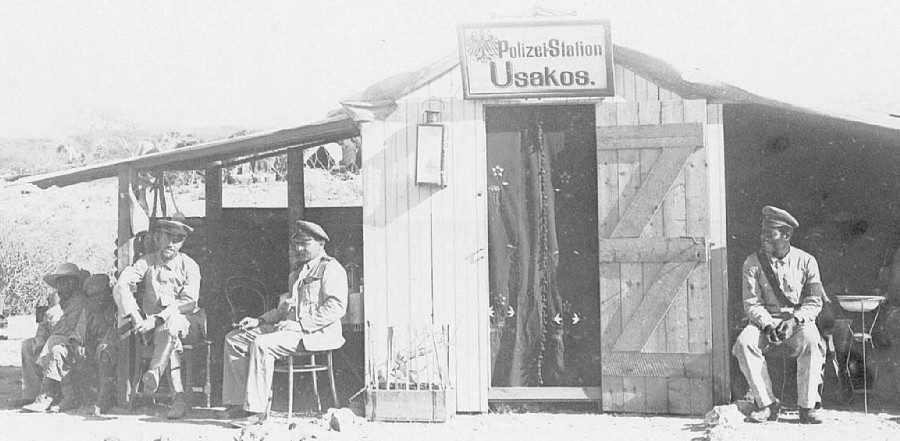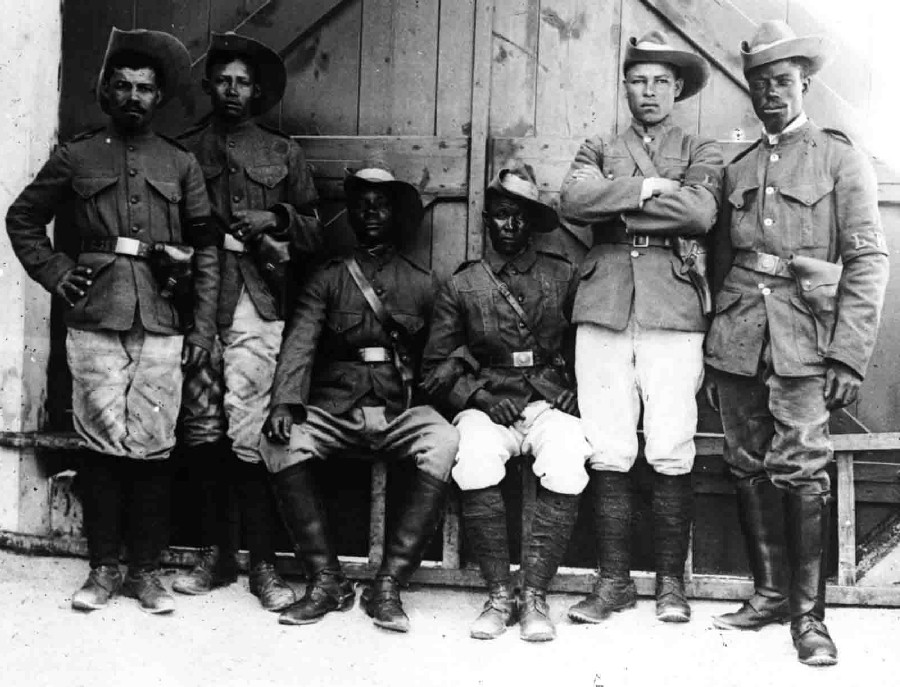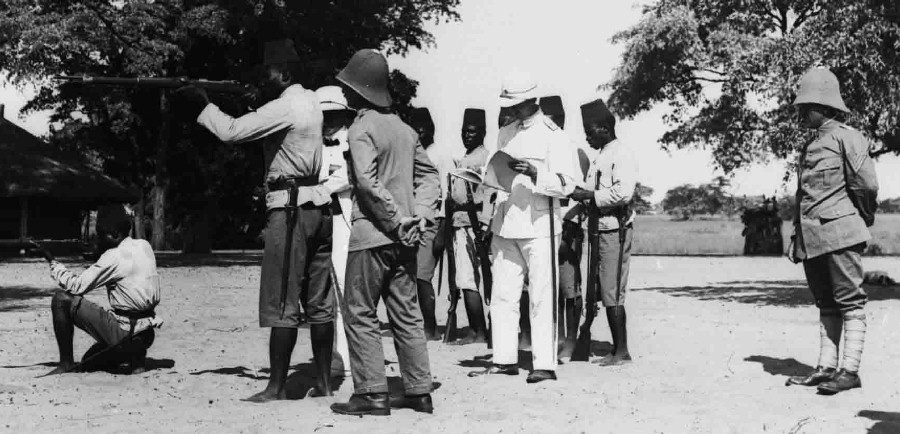|
German South West African
Landespolizei
African Auxiliaries - Polizei-Diener
 |
 |
 |
 |
 |
|
Figure 1
Polizei-Diener
South West Africa |
Figure 2
Polizei-Diener
South West Africa |
Figure 3
Polizei-Diener
Lüderitzbucht |
Figure 4
Polizei-Diener
Caprivi Strip |
Figure 5
Polizei-Diener
Caprivi Strip |
|
Unlike the Schutztruppe
in South West Africa, the Landespolizei regularly recruited Africans
into their ranks. These fully trained police constables were
known as known as "Polizei-Diener".
Schutztruppe Uniforms of the Polizei-Diener
Initially African Polizei-Diener wore standard
Schutztruppe uniforms, often stripped of insignia such as
shoulder straps and collar and cuff Litzen. Period photographs
show a variety of Schutztruppe uniforms were worn including the
1896 Khaki Feldrock, the
1896 Kord Waffenrock
and the obsolete 1894 Kord Waffenrock
along with the Südwester or cord peaked
cap. These uniforms were worn with a red sash over
the right shoulder to signify their police service.
| |
Figure 1 is based on a
photograph of an African Polizei-Diener.
Typically for many photographs of Africans serving with the
Schutztruppe and Landespolizei around the time of the Herero
Rebellion 1904-08 and before, this police assistant wears the
Schutztruppe
Kord Waffenrock
with blue piping, collar and cuffs but stripped of insignia such
as the collar and cuff Litzen and shoulder straps. He
wears a red sash over his shoulder to denote he is in police
service. His
Südwester hat probably has hatband and edging in blue for the
Schutztruppe of South West Africa, though it might possibly be
red which was the facing colour for the
Early Landespolizei
1905-07.
In the original photograph upon
which this illustration is based, are
several other African Police all wearing Schutztruppe corduroy uniforms
with a red sash over the shoulder. One wears an old
1894 Kord Waffenrock with Polish
cuffs. Some wear Südwester hats and one a Schutztruppe corduroy peaked cap.
|
Landespolizei Uniforms of the Polizei-Diener
From 1907 onwards standard Dark
Khaki Landespolizei Uniforms and Südwester hats were issued, sometimes again stripped
of shoulder straps and rank insignia. Another type of tunic has also
been seen in period photographs of the Polizei-Diener in Lüderitzbucht. It appears to be
khaki with a standing collar, five buttons down the front and pleated
pockets with triangular flaps. The origins
of this style of tunic are uncertain. Both
these uniforms were worn
with a red armband with the letters "LP" in white on the left arm.
A yellow metal "LP" badge was also authorised to be worn on the
right hand side of the Südwester hat instead of the Imperial crown worn
by German personnel in the Landespolizei. So far I have not been able to
find a period photograph proving the use of these badges nor indicating
any more details about what they may have looked like. While some African
Polizei-Diener appear in period photographs in
immaculately kept uniforms others seem to be wearing less well
kept second hand uniforms.
| |
Figure 2 is based on a
photograph of a
Polizei-Diener of the South West
African Landespolizei.
This figure wears an ill-fitting, battered 1907 Landespolizei Südwester and tunic
without the shoulder straps and missing a button. Note the red
armband with "LP" in white lettering on the left arm. His trousers and
boots are non-regulation.
Figure 3 is based on a
photograph of a Polizei-Diener taken in Lüderitzbucht. As
mentioned above a slightly different uniform was worn by the
Polizei-Diener of Lüderitzbucht, in khaki with a standing
collar, five buttons down the front and triangular pocket flaps.
Again note the red
armband with "LP" in white lettering on the left arm. The
Südwester hat is lacking its imperial cockade at the front and
may have the authorised yellow metal "LP" badge on the right
side although the angle of the original photograph upon which
this illustration is based makes it impossible to be sure. His
trousers appear to be of a lighter shade, possibly just more sun
bleached and are worn with puttees and short leather boots. A
Reichsrevolver 79 is carried on a brown leather belt with an
other ranks Schutztruppe belt buckle. As described below the
Lüderitzbucht Polizei-Diener were one of very few who were
authorised to carry firearms. |
Askari Uniforms of the Polizei-Diener in the
Caprivi Strip
The Caprivi Strip was a long thin piece of land ceded by the
British and added onto the German colony in 1890 as part
of the Heligoland-Zanzibar Treaty. It had strategic
importance but little other value. The 15 or so
Polizei-Diener of Schuckmannsburg
in the Caprivi Strip formed in August 1909 wore German East African
Askari Uniforms. According to the diary of Bezirksamtmann
Streitwolf, the district officer for Schuckmannsburg, it was
easier to source uniforms for his African troops from German
East Africa than from Windhoek.
The uniforms consisted of standard Askari
khaki tunics, with a stand and fall collar, plain cuffs, plain shoulder
straps and no pockets. The askari khaki trousers were worn gathered below the knees, without
puttees. While other Polizei-Diener wore khaki shorts, either
from cut down askari trousers or possibly purchased from nearby British
forces. One
Polizei-Diener photographed appears to wear leather gaiters and
boots (he may possibly be an NCO) but most are barefooted.
Headdress consisted either of the askari red fez with a short blue/black
tassel or the askari khaki tarbush with neckshade. From
period photographs it is
difficult to tell if the tarbush had the East African Schutztruppe white
metal eagle on the front. Leather
equipment and ammunition pouches are seen
in photographs to have been from the East African Schutztruppe (with
1887 ammunition pouches) and the South West African
Schutztruppe (being the standard issue mounted pattern).
| |
Figure 4
is based on a photograph of a Polizei-Diener
taken in Schuckmannsburg in the Caprivi Strip. He wears the East
African Askari khaki tarbush with neckshade, tunic and three
quarter length trousers. Like most Polizei-Diener in the Caprivi
strip he is barefooted. His brown leather equipment is the
pattern issued to the Schutztruppe of South West Africa with
ammunition pouches around the rear.
Figure 5
is based on a photograph of a Polizei-Diener
taken in Schuckmannsburg. He also wears East African Askari
uniform consisting of a red fez with blue/black tassel, khaki
tunic and three quarter length trousers. His is again
barefooted. He has a brown leather belt from which he carries an
S98 bayonet. He is also armed with a G98 rifle. |
Weapons
After the Herero Rebellion the German authorities forbade
Africans to carry firearms, including those in the
Landespolizei. Most were unarmed, a few carried bayonets of the S71/84
and possibly kS98 varieties. Exceptions to this rule were made
on very few occasions.
Bezirksamtmann Böhmer's
Polizei-Diener of
Lüderitzbucht were under his authority, allowed
to carry revolvers (the Reichsrevolver 79). The Polizei-Diener of the Caprivi strip were
authorised to carry rifles (the G98 rifle with S98
bayonet as noted above). On another occasion permission was
requested for a Polizei-Diener to carry a rifle with five rounds
as his courier duties took him through areas known to be home to
leopards and lions.
African Servants ("Bambusen")
Africans also served with the
Landespolizei as "Bambusen" or officers servants and batmen. They
often wore second-hand Landespolizei uniforms stripped of insignia but
without the "LP" armband. These men were not trained or
armed police and were not officially part of the police force.

Landespolizei Station at Usakos
The Germans are identified in this photograph as Railway Controller
Schwabe ("Eisenb. Betr. Kontr. Schwabe") and Polizeiwachtmeister
Ebrecht. The African on the right is named as Polizist
August. Note he is wearing a khaki tropical uniform with a red sash and
red "LP" armband.
Photo ©
Frankfurt University Koloniales Bildarchiv

Landespolizei in Lüderitzbucht
As mentioned above a slightly different uniform was worn by the Polizei-Diener of Lüderitzbucht, in khaki with a standing
collar, five buttons down the front and triangular pocket flaps.
Again note the red
armband with "LP" in white lettering on the left arm.
The men are armed with the
Reichsrevolver 79. As previously the
Lüderitzbucht Polizei-Diener were one of very few who were
authorised to carry firearms.
Photo ©
Frankfurt University Koloniales Bildarchiv

Landespolizei of the Caprivi Strip
This photograph was taken in Schuckmannsburg and shows the African
Polizei-Diener in rifle training. The Africans are wearing khaki East
African Askari uniforms, short khaki trousers and red fezzes. They are
armed with Gew98 rifles and S98 bayonets. The German instructors in the
photograph wear Schutztruppe white and khaki uniforms and tropical
helmets. Their rank insignia is also that of the Schutztruppe rather
than the Landespolizei suggesting that they were seconded to
Landespolizei duties. The officer in the centre has the shoulder straps
of an Oberleutnant and the NCO on the far right has the three chevrons
of a Vize-Feldwebel.
Photo ©
Frankfurt University Koloniales Bildarchiv
| |
|
|
 |
Special thanks for help on this
page goes to S Schepp who has been researching the
Landespolizei for many years and has recently published his
work on them-
"Unter
dem Kreuz des Südens-
Auf Spuren der Kaiserlichen Landespolizei von
Deutsch-Südwestafrika".
"This is the definitive study of the
Landespolizei in German South West Africa. As you would expect it
covers the
history, organisation, uniforms and equipment of the Landespolizei
but what it also does is bring these extensively researched facts
and figures to life by winding it around the life stories of many of
the policemen themselves. The author has travelled the world to find
descendants of the Landespolizei to find their own personal stories.
This touch, as well as the hundreds of previously unpublished facts,
photographs and illustrations makes this book a must for all those
interested in the German colonies."
See "Unter
dem Kreuz des Südens" for more details and how to
purchase this invaluable book. |
| |
|
|








